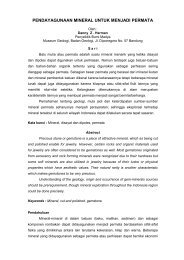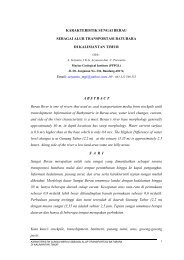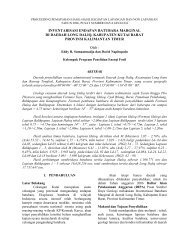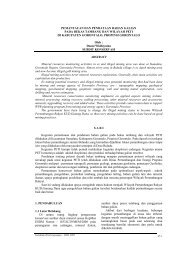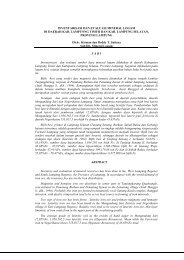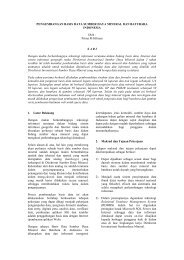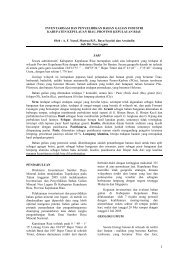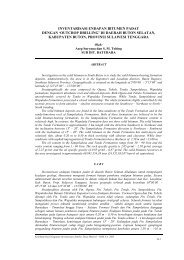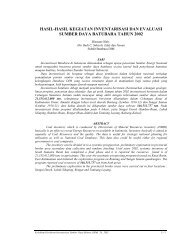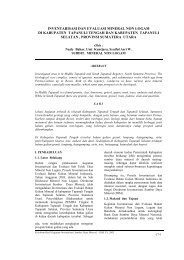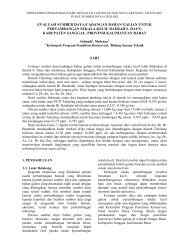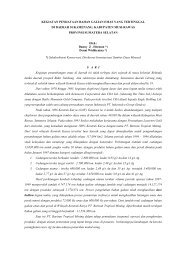MAKALAH ILMIAH - Pusat Sumber Daya Geologi
MAKALAH ILMIAH - Pusat Sumber Daya Geologi
MAKALAH ILMIAH - Pusat Sumber Daya Geologi
Create successful ePaper yourself
Turn your PDF publications into a flip-book with our unique Google optimized e-Paper software.
<strong>MAKALAH</strong> <strong>ILMIAH</strong>and the Bryozoan – Coraline Packestone –Grainstone microfacies.The Tendehantu Formation is dividedinto 2 lithofacies namely wackestone –packestone and packstone – grainstonelithofacies.The wackestone – packestonelithofacies in Tendehantu Formation, has 5observation stations, which showed poorlysorted with closed packing, the grains mainlyfrom 0.2 – 5 mm range, with moderatelyabrated and showed point and float contact(Figure 10). Petrographical analysis showedthat matrix content is ranging from 26 – 41%and pore visual from 7 – 15%, the dominantgrain is larger forams. Further analysis forthis lithofacies based on petrographicalanalysis, showed that it can be clustered into2 microfacies clusters, those are LargerForams Packestone and IndeterminatedBioclast – Algae Packestone. Thismicrofacies clustering will become aguidance for determining the quality ofreservoir candidate.The packestone – grainstone lithofaciesin Tendehantu Formation generally showeda poorly sorted feature in microscopic, with0.2 – 4 mm grain and moderately abrated,with point and float contact matrix range from34 – 45% (Figure 10). From furtherpetrographical analysis the lithofacies has 3microfacieses namely IndeterminatedBioclast Packestone, Larger ForamsBryozoan Packestone and Larger ForamsGrainstone.RESUME OF DIAGENESISBased on peterographic analysis, thediagenetic processes observed in Tabalarand Tendehantu Formations include asfollows:Microbial MicritizationThis process was a result of drillingactivity in skeletal grain by endolithic algae,fungi and bacteria forming holes and filledwith fine sediment or cement. This activity ismarked by the presence of micrite envelope.If the hole is not filled up by fine sediment, thehole will be corroded and the moldic porosityformed. Micritization is an important processin both stagnant and active marine phreaticzones (Longman, 1982).DissolutionDissolution occured when thediagenetic environment were different, theminerals became unstable and dissolvedeasily and then transformed into more stableminerals in a new environment. Dissolutioni n t e n s i v e l y h a p p e n e d i n s e v e r a lmicrofacieses in Tabalar Formation,produced secondary porosity as moldic andvuggy (Figure 10 - B). Dissolution occurredas well in freshwater vadose or freshwaterphreatic environments (Longman,1982).CementationThis processes occured when the poreswere fluid supersaturated and there was nokinetic factor hampering the cementprecipitation. Based on the analysis inTabalar and Tendehantu there are threekinds of cement that can observed: fibrous,blocky and bladed. Bladed and blocky weredominantly observed in Tabalar Formation.Bladed and fibrous cement showed marinephreatic environment, while blocky formed inmeteoric phreatic (Figure 11).NeomorphismNeomorphism is a diagenetic productthat has larger size inverse micriterecrystalization. The formed crystal showedmore clouded colour than spar cement andmicrospar. Neomorphism occured inmeteoric phreatic environment and presentdominantly in both formations.CompactionMechanical and chemical compactionoccur in deep burial environment, caused bypressure and fluid involved. In TabalarFormation compaction feature showed grainfractures and stylolites. This diageneticprocesses gave a huge effect to reduce thepore value.Based on the processes explainedabove, it can be summarized that thesequence of diagenetic processes in Tabalarand Tendehantu Formations are:First stage diagenesis occured inmarine phreatic and fresh water phreaticzone characterized by the occurrenceofmicritization, fibrous and equant cement.Second stage is burial environment,shown by mechanical compaction and83Buletin <strong>Sumber</strong> <strong>Daya</strong> <strong>Geologi</strong> Volume 7 Nomor 2 - 2012



